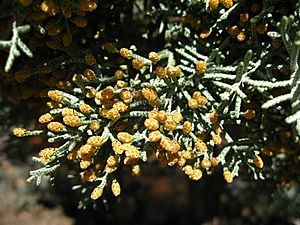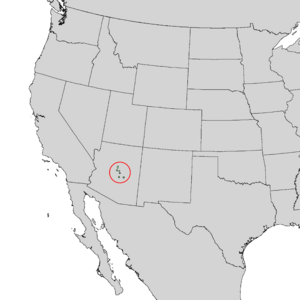Cupressus arizonica var. glabra facts for kids
Quick facts for kids Cupressus arizonica var. glabra |
|
|---|---|
 |
|
| Male pollen cones | |
| Conservation status | |
| Scientific classification |
|
| Kingdom: | Plantae |
| Clade: | Tracheophytes |
| Division: | Pinophyta |
| Class: | Pinopsida |
| Order: | Pinales |
| Family: | Cupressaceae |
| Genus: | Cupressus |
| Species: | |
| Varietas: |
C. a. var. glabra
|
| Trinomial name | |
| Cupressus arizonica var. glabra (Sudw.) Little
|
|
 |
|
| Natural range of Cupressus arizonica var. glabra | |
| Synonyms | |
|
|
The Arizona smooth bark cypress (scientific name: Cupressus arizonica var. glabra) is a special type of tree. It is a conifer, which means it produces cones and has needle-like or scale-like leaves. This tree is native to the southwestern United States.
You can find it growing naturally in the canyons and slopes around Sedona, Arizona. This unique tree was first officially described in 1910 by a scientist named George Bishop Sudworth.
What Makes It Special?
Smooth Bark
The Arizona smooth bark cypress is easy to tell apart from other similar trees. Its main feature is its very smooth bark. Unlike some other cypress trees, its bark does not have deep grooves or furrows.
The bark can come in beautiful shades. You might see it in pink, cherry red, or even gray colors. This smooth, colorful bark gives the tree its name.
Growing in Gardens
This tree is often planted in gardens and parks. It is a popular choice for landscaping. One big reason for its popularity is its strong resistance to a plant disease called cypress canker.
Cypress canker is a serious disease that can harm or even kill many cypress trees. However, the Arizona smooth bark cypress is almost immune to it. This makes it a very hardy and reliable tree for many places.
See also
 In Spanish: Ciprés glabro de Arizona para niños
In Spanish: Ciprés glabro de Arizona para niños


